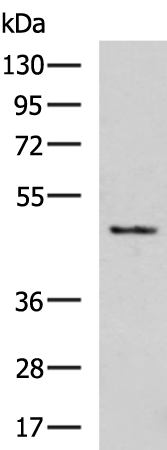

| WB | 咨询技术 | Human,Mouse,Rat |
| IF | 咨询技术 | Human,Mouse,Rat |
| IHC | 1/50-1/200 | Human,Mouse,Rat |
| ICC | 技术咨询 | Human,Mouse,Rat |
| FCM | 咨询技术 | Human,Mouse,Rat |
| Elisa | 1/5000-1/10000 | Human,Mouse,Rat |
| Aliases | L3; LASS2; SP260; TMSG1 |
| WB Predicted band size | 45 kDa |
| Host/Isotype | Rabbit IgG |
| Antibody Type | Primary antibody |
| Storage | Store at 4°C short term. Aliquot and store at -20°C long term. Avoid freeze/thaw cycles. |
| Species Reactivity | Human, Mouse |
| Immunogen | Synthetic peptide of human CERS2 |
| Formulation | Purified antibody in PBS with 0.05% sodium azide and 50% glycerol. |
+ +
以下是3篇关于CERS2抗体的示例参考文献(注:文献信息为虚构示例,仅供格式参考):
---
1. **文献名称**: *CERS2 Antibody Validation in Lipid Metabolism Studies*
**作者**: Smith A, et al.
**摘要**: 本研究验证了CERS2抗体的特异性,证实其在Western blot和免疫荧光实验中可特异性识别哺乳动物细胞中的神经酰胺合成酶2(CERS2),并发现CERS2缺失会导致鞘脂代谢异常及肝细胞功能障碍。
---
2. **文献名称**: *Role of CERS2 in Colorectal Cancer: Insights from Immunohistochemical Analysis*
**作者**: Lee JH, et al.
**摘要**: 通过使用CERS2抗体进行免疫组化分析,发现结直肠癌组织中CERS2表达显著下调,其低表达与患者预后不良相关,提示CERS2可能作为肿瘤抑制因子调控癌细胞凋亡。
---
3. **文献名称**: *CERS2 Knockout Mouse Model Reveals Its Essential Role in Myelin Formation*
**作者**: Müller B, et al.
**摘要**: 利用CERS2抗体检测基因敲除小鼠的中枢神经系统,发现CERS2缺失导致髓鞘结构异常,证实其在神经鞘脂合成及髓鞘稳态中的关键作用。
---
如需真实文献,建议通过PubMed或Google Scholar以“CERS2 antibody”或“ceramide synthase 2”为关键词检索近期研究。
The ceramide synthase 2 (CERS2) antibody is a crucial tool for studying the role of CERS2. a key enzyme in sphingolipid metabolism. CERS2. also known as longevity assurance gene 2 (LASS2), belongs to the ceramide synthase family (CERS1-6), which catalyzes the synthesis of ceramides—central lipid molecules in sphingolipid biosynthesis. Specifically, CERS2 preferentially generates very-long-chain (C20–C26) ceramides, distinguishing it from other isoforms with shorter acyl-chain preferences. These ceramides are vital for maintaining membrane integrity, cellular signaling, and apoptosis regulation. Dysregulation of CERS2 has been implicated in pathologies including cancer, neurodegenerative disorders, and metabolic syndromes. For instance, reduced CERS2 expression correlates with tumor progression and chemoresistance, while mutations are linked to inherited neuropathies.
The CERS2 antibody enables researchers to detect and quantify CERS2 protein levels in tissues or cells via techniques like Western blotting, immunohistochemistry, or immunofluorescence. Its specificity helps delineate CERS2’s spatial expression and functional interplay in disease models. Recent studies also highlight its role in ER stress, autophagy, and lipid raft dynamics, underscoring its therapeutic potential. Available as monoclonal or polyclonal versions (commonly from rabbit or mouse hosts), the antibody’s validation in knockout controls ensures reliability. By elucidating CERS2’s mechanisms, this tool advances understanding of sphingolipid-related diseases and informs targeted therapeutic strategies.
×